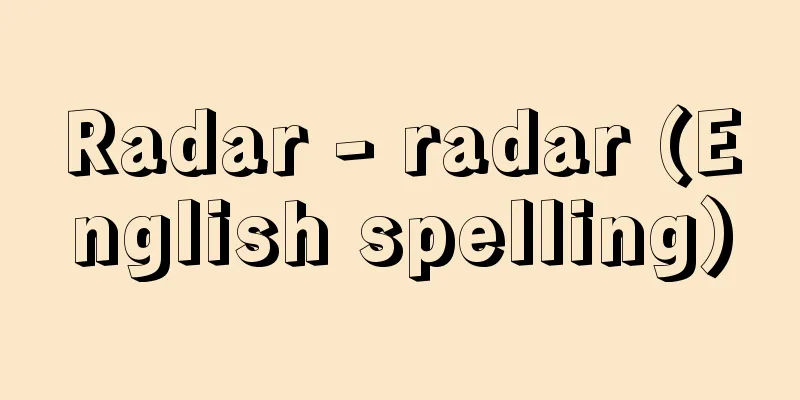Radar - radar (English spelling)

|
A device that detects targets by emitting electromagnetic waves and receiving the echoes of the electromagnetic waves reflected from the surface of the target. The presence of the target is revealed by the detection of the echo or the time and direction until a response signal is received from a transponder (radar transponder) inside the target. The term radar was first used by U.S. Navy personnel during World War II as a contraction of radio detection and ranging, and was standardized worldwide after the war. Information on the target can be obtained by determining the distance from the time between the emission and reception of the electromagnetic wave, the direction from the maximum reception angle of the electromagnetic wave due to the rotation and turning of the antenna, and the shape and attributes of the target from the properties of the echo. Radar can also perform passive operations by stopping the transmitter and detecting the electromagnetic waves emitted by the target itself or the reflected waves caused by the irradiation of electromagnetic waves from outside. [Michinori Iwata] historyThe idea of using electromagnetic waves to detect objects was proposed by Croatian-born Serbian-American Tesla in 1889. In 1904, German Christian Hulsmeyer patented a device for preventing ships from colliding with each other using electromagnetic waves. In 1922, Marconi, the father of wireless telegraphy, proposed that shortwave radio waves could be used to prevent ship collisions as part of the spread of shortwave radio waves in the UK, and in the US, AH Taylor and LC Young of the Naval Research Laboratory recognized that radio waves could be jammed by ships while conducting shortwave experiments across the Potomac River. In 1931, Taylor's group detected airplanes 65 km away using a 60 MHz FM Doppler radar. G. Bright and Merie Antony Tuve (1901-1982) of Carnegie University in Washington launched a 0.5 millisecond pulse to observe the ionosphere, which was received by a receiver 13 kilometers away. This was the beginning of pulse radar. Based on Young's suggestion, development continued in the United States, and 28 MHz pulse radar was developed in 1936, and 200 MHz pulse radar in 1937. At the time, radar was called radio locator in the UK, and the development of pulse radar began in 1934 as a countermeasure against German air force aircraft. Watson-Watt of the Physical Laboratory succeeded in detecting aircraft 23 km away in 1935, and 120 km away (at an altitude of 450 m) in 1936 using a large 70-meter antenna. Next, in 1939, he developed the 200 megahertz (1.5-meter wave) Chain-Home-Low (CHL) radar, which proved effective in shooting down German air force aircraft. Radar was perfected in its present-day form in 1940, the year after the start of World War II, when the United States established the Radiation Laboratory at Massachusetts Institute of Technology to provide military aid to Britain, and began full-scale radar development. The laboratory introduced the British experience that "shortening the electromagnetic wave is effective" and the technology of the strapping multi-cavity magnetron. The laboratory developed microwave electron tubes, essential for radar, PPI (Plane Position Indicator) displays that show targets as if they are moving on a map, as well as radio navigation devices such as Loran and Decca, and radio landing support devices such as GCA and ILS. The laboratory was dissolved at the end of the war. France developed equipment that used metre and decimetre waves as obstacle detectors for ships, and in 1935, 20-centimeter waves were able to detect ships 10 kilometers away and coastlines 20 kilometers away. Germany developed a radar called Würzburg, and in 1935 developed a mystery system that used 10-centimeter waves to detect airplanes even in fog, but stopped development as it was not suitable for attack. When development resumed, magnetrons did not exist, and they could only produce something that was behind other countries. In Japan, radar was called an electric wave detector, or "den-ra" for short, and in 1939 (Showa 14), the Army developed a meter wave FM radar. In 1941, the Army used a meter wave pulse radar to detect airplanes 250 kilometers away, and the Navy successfully experimented with a 10 cm wave surface warning radar, developing a magnetron comparable to that of the UK. Full-scale production began in 1942 after the capture of American and British radars in Singapore and Corregidor, and in reflection on the defeat at the Battle of Midway, and both the Army and Navy began equipping all their ships with radars, and they deployed radars in combat, and by the end of World War II, 30 types of radars, including 10 cm wave radars, had been developed and were in use. After World War II, it was produced primarily as a civilian radar for ships, and its uses have expanded to include aviation and observation radars. [Michinori Iwata] kindsRadars are widely used for identifying, navigating, monitoring, observing, and measuring aircraft, rockets, ships, airports, harbors, and atmospheric conditions. In the early days, electromagnetic waves from 100 megahertz to 10 gigahertz, or three meters to three centimeters in wavelength, were used. However, the higher the frequency of the electromagnetic waves, the higher the antenna efficiency and the better the resolution, but the higher the frequency, the shorter the reach, so practical radars of 3 gigahertz to 10 gigahertz have become mainstream. Currently, radars with a wave of 4 millimeters are also used, especially for short-distance airport surveillance. Laser light, an even shorter electromagnetic wave, is also used for distance measurement, air pollution observation, and missile tracking. Radars are broadly divided into primary radar and secondary radar. Primary radars irradiate a target with pulsed or continuous electromagnetic waves and detect weak signals reflected from the target. In addition, there are passive radars that are dedicated to passive radars and bistatic radars that geographically separate the transmitter and receiver. Primary radars are divided into pulse radar and continuous wave (CW) radar, with the former being more widely used. Pulse radars aim electromagnetic waves modulated with square pulses at a target and detect the resulting weak echoes. The distance is measured by the round-trip time of the pulse, and the shape and speed are identified, measured, and displayed by the magnitude and changes in the returning pulse. Pulse radars that add frequency modulation and phase modulation within the transmission pulse width to improve distance resolution and expand the occupied frequency band are called pulse compression radars. Continuous wave radar is also called Doppler radar, and is used to detect the Doppler effect of electromagnetic waves accompanying the movement of a target and observe its speed of movement. In this case, if the Doppler frequency is considered an audible frequency, the movement of people and vehicles can be heard as a realistic sound. In addition, since a pure sine wave alone does not have the ability to measure distances, a radar that adds repeated frequency modulation to increase the amount of information in the signal and can also measure distances is called a frequency-modulated continuous wave radar (FM-CW radar). If the frequency modulation frequency is lowered and the bandwidth is widened to make the distance increments smaller, it can be used to measure very close distances that are impossible with pulse radar, and for radio altimeters that measure distances with high precision. In a secondary radar, a transponder in the target receives the transmitted signal from the radar, which then drives a transmitter in the transponder to send a signal of a different wavelength back to the original radar. This makes it easier to identify targets and can extend the range, so it is used in distance measuring devices, etc. The uses of radar can be broadly divided into search and tracking. Search radar uses a wide electromagnetic beam, while tracking radar uses a narrow beam, and a computer is used for data processing. [Michinori Iwata] mechanismThe azimuth resolution, which is the basic performance of a radar, is 70 times the frequency of the electromagnetic waves used divided by the antenna diameter (meters), and the distance resolution is 150 times the pulse width expressed in microseconds. The maximum range is proportional to the product of the fourth root of the transmission power, the square root of the frequency used, and the antenna diameter. Pulse radar consists of a transmitter, antenna, transmit/receive switch, receiver, and display. The transmitter modulates a high-power magnetron or klystron with output ranging from 1 kilowatt to several megawatts, or a small semiconductor (GaAs) oscillator, to generate pulses with widths ranging from a few microseconds to a few tenths of a microsecond, hundreds to thousands of times per second. The generated pulses reach the antenna while driving a transmit/receive switch installed inside a waveguide. The transmit/receive switch is a gas discharge tube consisting of an ATR (anti-transmit receive tube) and a TR (transmit receive tube), which is lit by a transmit pulse to prevent the pulse from entering the receiver. Parabolic antennas are the most common type of antenna. For example, for ships, a parabolic cylindrical reflector is used to allow the electromagnetic beam to be wide vertically and narrow horizontally, taking into account the motion of the ship, and it performs fan-shaped scanning by rotating or swiveling. Phased array antennas, which do not require mechanical rotation or swiveling, are also used for special purposes. The radio waves emitted from the antenna hit the target, pass through the antenna again, and travel in reverse through the same waveguide that the transmitted pulse passed through. At this time, the voltage of the received pulse is small, so the TR and ATR tubes do not light up, and the shape of the waveguides in which they are attached prevents the received pulse from entering the transmitter. The received pulse that passes through the waveguide enters the receiver and is mixed with the signal from the local oscillator to become an intermediate frequency signal. It then passes through an intermediate frequency amplifier, a detector, and a video amplifier, which changes the brightness signal of the CRT. There are many display methods for CRTs, but the PPI method creates a radial electron beam in succession, like an opening fan, in sync with the movement of the antenna, and places a signal on it to obtain a map-like display. There are also other methods that display the time axis and signal, or the azimuth angle and distance, in orthogonal coordinates. [Michinori Iwata] applicationShips are equipped with millimeter, 3-centimeter, 5-centimeter, and 10-centimeter wave radars depending on the purpose, and in ports, harbor radars ensure the safety of ship operations. Airports are equipped with a variety of radars, including Airport Surveillance Radar (ASR), Precision Approach Radar (PAR), Side Look-Ahead Radar (SLAR), Airport Surface Detection Radar (ASDE), Secondary Surveillance Radar (SSR, DABS), Air Route Surveillance Radar (ARSR), and 3D radars, which are all interrelated and ensure the safety of aircraft takeoff and landing. There are also Synthetic Aperture Radars, which use the movement of small antennas mounted on aircraft and satellites to create topographical maps with the characteristics of large antennas, Terrain Following Radars to avoid collisions with mountains, and OTH Radars to monitor beyond the horizon. In addition, weather radars observe cloud movement, atmospheric radars constantly monitor wind movement, temperature, and density distribution 20 to 30 kilometers above the ground, and underground radars, although limited in depth, are used to explore resources at 100 kilohertz to 1 megahertz, strata and mineral deposits at 1 to 100 megahertz, buried objects at 100 megahertz to 1 gigahertz, and the state of the earth's surface and strata at 1 gigahertz to several tens of gigahertz. In Antarctica, ice at a depth of 1,800 meters is observed at 30 megahertz. Underwater, frequencies of several tens of kilohertz or less are used, which have little attenuation. Doppler radars use the Doppler effect to determine the ground speed of aircraft by using the reflection of radio waves emitted to the ground. Speed guns (radar guns) can easily measure the speed of a baseball or a car. Although millimeter-wave radar has a short range, the development of antenna technology and MMIC (monolithic microwave integrated circuit) has led to the miniaturization and weight reduction of radar, and it is being put to practical use as a collision prevention technology for automobiles. In addition, millimeter-wave imaging arrays, also called millimeter-wave cameras, are made by arranging detection elements in a planar shape and synthesizing the reflected waves that enter each element to create images (photos). They are resistant to fog, clouds, and dust, and can take pictures through flames, making them suitable for use in vehicles, ground monitoring from helicopters, volcanic activity, nuclear power plants, etc. Rescue radars have also been developed to detect the heartbeats of survivors buried in accidents and disasters. Radar that uses light waves (laser radar), also known as lidar (light radar), is used to measure aerosols (suspended particles, aerosols, or aerosols) caused by volcanic eruptions, the ozone layer, and atmospheric temperatures in the upper atmosphere, because light is strongly scattered by small particles and molecules in the atmosphere. [Michinori Iwata] "Radio Detectors" by Kihira Makoto (1945, Kobundo)" ▽ "Radar" by Ito Yoji and Takahashi Shuichi (1953, Koyosha)" ▽ "The Fundamentals of Radar Engineering" by Yoshimura Yoshihiro and Fujimori Masayuki (1971, Keigaku Publishing)" ▽ "Radar Signal Processing Technology" by Sekine Matsuo (1991, Institute of Electronics, Information and Communication Engineers, Corona Publishing)" ▽ "Synthetic Aperture Radar (SAR)" (1992), compiled and published by the Resources Observation and Analysis Center" ▽ "Introduction to Radio Applications" by Fujimoto Kyohei (1993, Kyoritsu Publishing)" ▽ "Radar Technology" revised edition by Matsumura Masanori et al., supervised by Yoshida Takashi (1996, Institute of Electronics, Information and Communication Engineers, Corona Publishing)" ▽ "Radar Warfare in World War II - From the History of the Development of Radar Technology in Germany" (1997), edited and translated by Tanaka Kotaro "New Radio Engineering" by Hashimoto Osamu and Kawasaki Shigeo (1998, Baifukan)" ▽ "Radio Information Engineering" by Kondo Michimasa (1999, Kyoritsu Shuppan)" ▽ "Radio Measurements and Radio Navigation in Space" by Takano Tadashi, Sato Toru, Kashiwamoto Masami, and Murata Masaaki (2000, Corona Publishing)" ▽ "Fundamentals and Applications of Radio Waves" by Miwa Susumu (2000, Tokyo Denki University Press)" ▽ "Coastal Ocean Observation by Land-Based Radar" edited by the Japan Society of Civil Engineers (2001, Maruzen) [References] | | | | | | | | | | | | | Wave | | | | | | |©Shogakukan "> Pulse radar mechanism Source: Shogakukan Encyclopedia Nipponica About Encyclopedia Nipponica Information | Legend |
|
電磁波を放射し、目標物体表面から反射される電磁波のエコーを受信して目標物を検知する装置をいう。目標物の存在は、エコーの検出、または目標物内のトランスポンダー(レーダー応答機)からの応答信号を受信するまでの時間と方向により明らかになる。レーダーの呼称は、無線波の検出と測距の意味のradio detection and rangingの縮小語としてアメリカ海軍の関係者が第二次世界大戦中に使い始め、戦後に世界的に統一された。 目標物の情報としては、電磁波の放射と受信間の時間から距離が得られ、アンテナの旋回・回転による電磁波の最大受信角度から方向が、エコーの性質から対象物の形状や属性が得られる。レーダーでは送信機を停止して、目標物それ自体が発する電磁波、または外部からの電磁波の照射による反射波を検出するパッシブ型の動作も行う。 [岩田倫典] 歴史電磁波を用いて物体を検出しようというアイデアは、1889年にクロアチア生まれのセルビア系アメリカ人テスラが提案した。1904年にはドイツのハルスマイヤーChristian Hulsmeyerが電磁波を用いた船の衝突防止装置の特許を得ている。 イギリスでは、1922年に無線電信の父マルコーニが短波の普及の一環として、短波を船の衝突防止に役だてるべきだと提案し、アメリカでは海軍研究所のテーラーA. H. TaylorとヤングL. C. Youngがポトマック川を挟んで短波の実験中に、船によって電波が妨害されることを認めた。1931年にテーラーのグループは60メガヘルツ波のFMドップラーレーダーで65キロメートル先の飛行機を探知している。 ワシントンのカーネギー大学のG・ブライトとチューブMerie Antony Tuve(1901―1982)は、電離層の観測のために0.5ミリ秒のパルスを打ち上げ、13キロメートル離れた受信機で受信した。これがパルスレーダーの始まりである。アメリカではヤングの示唆によって開発が進められ、1936年には28メガヘルツ、1937年には200メガヘルツのパルスレーダーが開発された。 当時、イギリスではレーダーをラジオロケーターとよんだが、ドイツ空軍機の対策として1934年にパルスレーダーの開発が開始された。物理研究所のワトソン・ワットは1935年には23キロメートル先、1936年には70メートルの大型アンテナにより120キロメートル先(高度450メートル)の飛行機をとらえることに成功した。ついで、1939年にはドイツ空軍機の撃墜に威力を発揮した200メガヘルツ(1.5メートル波)のチェーン・ホーム・ロー(CHL)・レーダーを開発している。 レーダーが今日の形に完成されたのは、第二次世界大戦開始翌年の1940年にアメリカが、イギリスへの軍事援助の目的でマサチューセッツ工科大学内に放射研究所を設立し、本格的なレーダーの開発を行ったことによる。ここには、イギリスから「電磁波を短くするとよい」という経験と、ストラッピング多空胴マグネトロン(磁電管)の技術が導入された。研究所は、レーダーに不可欠なマイクロ波電子管、目標物があたかも地図上を移動するように表示するPPI(Plane Position Indicator)表示装置のほか、ロラン、デッカなどの電波航法装置、GCA、ILSなどの着陸支援の電波装置を開発した。この研究所は終戦とともに解散した。 フランスでは船舶の障害探知機としてメートル波、デシメートル波を利用する装置を開発し、1935年には20センチメートル波で船なら10キロメートル先、海岸線なら20キロメートル先を探知している。ドイツではレーダーをウルツブルクとよび、1935年には10センチメートル波を利用して霧の中でも飛行機を探知できるミステリーシステムを開発したが、攻撃向きでないとして開発を中断した。開発再開時にはマグネトロンはなく、他国に遅れたものしかできなかった。 日本ではレーダーを電波探知機、略して電探とよび、1939年(昭和14)には陸軍がメートル波のFM式レーダーを開発した。1941年には陸軍がメートル波によるパルスレーダーで250キロメートル先の飛行機を探知し、海軍は10センチメートル波の水上警戒用レーダーの実験に成功して、イギリスに匹敵するマグネトロンを開発している。生産が本格化したのは、1942年シンガポールとコレヒドールで米英軍のレーダーを捕獲したことと、ミッドウェー海戦の敗北への反省からで、全艦艇に電探を搭載するなど陸海軍とも実戦配備が進み、第二次世界大戦終戦までに10センチメートル波など30種のレーダーが開発され使用された。 第二次世界大戦後は、民間用レーダーとしてもっぱら船舶用のものが生産され、航空機用や観察用にも用途を広げている。 [岩田倫典] 種類レーダーは航空機、ロケット、船舶、空港、港湾、大気状態などの識別、航行支援、監視、観察、測定などに広く用いられる。初期には100メガヘルツ~10ギガヘルツ、つまり波長3メートル~3センチメートルの電磁波が用いられた。しかし、電磁波の周波数が高いほどアンテナの効率は高く、分解能はよくなるが、周波数が大きくなると到達距離が短くなることから、実用的な3ギガヘルツ~10ギガヘルツのレーダーが主流となっている。現在では、とくに近距離の空港監視などに4ミリメートル波のものも使用されている。さらに短い電磁波であるレーザー光も、距離測定、大気汚染観察、ミサイルの追跡などに使用されている。 レーダーは、一次レーダーと二次レーダーに大別される。一次レーダーは、パルス状または連続した電磁波を目標に照射して、目標物から反射による微弱な信号を検出するものである。このほか、パッシブ型専用のパッシブレーダーや、送信側と受信側を地理的に分離したバイスタティックレーダーがある。 一次レーダーにはパルスレーダーと連続波(CW)レーダーがあり、前者が広く用いられる。パルスレーダーは、電磁波を方形(ほうけい)パルスで変調したものを目標物に当て、その微弱なエコーを検出するものである。パルスの往復時間で距離を、戻りパルスの大きさと変化で形状・速度を識別・測定して表示する。パルスレーダーで、距離分解能を改善するために送信パルス幅内で周波数変調や位相変調を加え、占有周波数帯域を広げたものをパルス圧縮レーダーとよぶ。 連続波レーダーは、目標物の移動に伴う電磁波のドップラー効果を検出してその移動速度を観測するのに用いるもので、ドップラーレーダーともいう。この際、ドップラー周波数を可聴周波数とすると、人間や車両の動きを臨場感のある音として聞くことができる。また純粋な正弦波だけでは測距能力がないので、繰り返し周波数変調を加えて信号の情報量を増し、距離も測れるようにしたものを周波数変調連続波レーダー(FM-CWレーダー)とよぶ。周波数変調の周波数を低く、帯域を広げて距離の刻みを小さくすると、パルスレーダーでは不可能な超近距離の測定や、高精度で距離を測る電波高度計に使用できる。 二次レーダーは、レーダーからの送信信号を目標物にあるトランスポンダーが受け、その信号によりトランスポンダー内の送信機を駆動して別の波長の信号を元のレーダーに送り戻すものである。これによると、目標を識別することが容易で到達距離を伸ばすことができるので、測距装置などに利用されている。 レーダーの使用目的は、探索用と追跡用に大別できる。探索用は幅の広い電磁波のビームが、追跡用には細いビームが用いられ、情報処理にはコンピュータを連動させている。 [岩田倫典] 機構レーダーの基本となる性能である方位分解能は、使用電磁波の周波数をアンテナ直径(メートル)で割ったものを70倍したものであり、距離分解能はマイクロ秒で表したパルス幅の150倍である。最大到達距離は、送信電力の4乗根、使用周波数の平方根、アンテナ径の積に比例する。 パルスレーダーは、送信部、アンテナ、送受切り替え部、受信部、表示部からできている。送信部は、1キロワットから数メガワットの大出力マグネトロンやクライストロンを、小型では半導体(GaAs)発振器を変調し、数マイクロ秒から数十分の1マイクロ秒幅のパルスを毎秒数百から数千回繰り返し発生させる。発生したパルスは、導波管内に設けられた送受切り替え器を駆動しながらアンテナに達する。送受切り替え器はATR(anti-transmit receive tube)とTR(transmit receive tube)のガス放電管で、送信パルスで点灯されることにより、パルスが受信部に入ることを妨げる。 アンテナはパラボラ型のアンテナが一般的である。たとえば船舶用には、船の動揺を考慮して、電磁ビームが垂直を広く、水平を狭くとれるように放物円筒反射鏡を用いており、旋回・回転などの扇状走査を行う。特殊な用途には機械的な旋回・回転の不要なフェーズドアレイアンテナも用いられる。 アンテナから放射された電波は目標物に当たり、ふたたびアンテナを経て送信パルスが通ったのと同じ導波管を逆に通る。この際、受信パルスの電圧は小さいので、TR管とATR管は点灯せず、両者の装着されている導波管の形状により送信部に受信パルスが入るのが妨げられる。導波管を通った受信パルスは受信機に入り、局部発振器の信号と混合され、中間周波数の信号となる。ついで、中間周波増幅器、検波器、映像増幅器を経て、ブラウン管の輝度信号を変化させる。ブラウン管での表示方式は多いが、PPI方式では、扇を開くように放射状の電子ビームをアンテナの動きと同期して次々とつくり、その上に信号をのせて地図状の表示を得るものである。このほか、時間軸と信号、方位角と距離というように直交座標で表示するものなどがある。 [岩田倫典] 応用船舶には目的に応じてミリメートル波(ミリ波)、3センチメートル波、5センチメートル波、10センチメートル波のレーダーが設置され、港湾では港湾レーダーが船舶の運行の安全を図っている。 空港には、空港監視レーダー(ASR)、精測進入レーダー(PAR)、側方監視レーダー(SLAR)、空港面探知レーダー(ASDE)、二次監視レーダー(SSR、DABS)、航空路監視レーダー(ARSR)や三次元レーダーが相互に関連して設置され、航空機の離着陸の安全を図っている。また、航空機や人工衛星に搭載された小型アンテナの移動を利用して大型アンテナのような性格をもち地形図を作成する合成開口レーダー、山などとの衝突を避ける地形追従レーダーや、水平線を越えて監視するOTHレーダーがある。 このほか、気象観測レーダーは雲の動きを観測し、大気観測レーダーは地上20~30キロメートルの風の動き、温度、密度の分布を恒常的に監視し、地中探索レーダーは深さには限度があるものの100キロヘルツ~1メガヘルツで資源を、1~100メガヘルツで地層や鉱層を、100メガヘルツ~1ギガヘルツで埋没物を、1ギガヘルツ~数十ギガヘルツで地表・地層の状態を探査するのに用いられる。南極では30メガヘルツで深さ1800メートルの氷を観測している。水中では減衰の少ない数十キロヘルツ以下を用いる。ドップラー効果を利用したドップラーレーダーでは、地表に放射した電波の反射を利用して航空機の対地速度などを求めることができる。また、スピードガン(レーダーガン)は球速や自動車の速度を手軽に計測できる。 ミリ波レーダーは到達距離は短いがアンテナ技術やMMIC(モノリシック・マイクロ波集積回路)の開発により、小型・軽量化が進み自動車の衝突予防技術として実用化が進んでいる。また、ミリ波カメラともよばれるミリ波イメージングアレイは、検出素子を面状に配列して各素子に入る反射波を合成して映像(写真)をつくるもので、霧、雲、ダストに強く、火炎を通して撮影できることから、車載用、ヘリコプターなどからの地上監視、火山活動、原子力発電所などの監視に適する。また、事故や災害などで埋没されている生存者の心拍を検出するレスキューレーダーも開発されている。 光波を用いるレーダー(レーザー・レーダー)は、光レーダーの意味でライダーlidar(light radar)ともよばれるが、光が大気中の微粒子や分子による散乱を強く受けることから、火山爆発によるエーロゾル(浮遊微粒子、煙霧質、エアロゾルともいう)、オゾン層、超高層の大気温度の測定に用いられる。 [岩田倫典] 『紀平信著『電波探知機』(1945・広文堂)』▽『伊藤庸二・高橋修一著『レーダー』(1953・興洋社)』▽『吉村義弘・藤森允之著『レーダ工学の基礎』(1971・啓学出版)』▽『関根松夫著『レーダ信号処理技術』(1991・電子情報通信学会、コロナ社発売)』▽『資源観測解析センター編・刊『合成開口レーダ(SAR)』(1992)』▽『藤本京平著『入門電波応用』(1993・共立出版)』▽『吉田孝監修、松村正典ほか著『レーダ技術』改訂版(1996・電子情報通信学会、コロナ社発売)』▽『田中浩太郎編訳・刊『第2次世界大戦におけるレーダー戦争――ドイツのレーダー技術発達史より』(1997)』▽『橋本修・川崎繁男著『新しい電波工学』(1998・培風館)』▽『近藤倫正著『電波情報工学』(1999・共立出版)』▽『高野忠・佐藤亨・柏本昌美・村田正秋著『宇宙における電波計測と電波航法』(2000・コロナ社)』▽『三輪進著『電波の基礎と応用』(2000・東京電機大学出版局)』▽『土木学会編『陸上設置型レーダによる沿岸海洋観測』(2001・丸善)』 [参照項目] | | | | | | | | | | | | | | | | | | | |©Shogakukan"> パルスレーダーの機構 出典 小学館 日本大百科全書(ニッポニカ)日本大百科全書(ニッポニカ)について 情報 | 凡例 |
<<: Le Thanh Tong (English spelling)
>>: Leda - Leda (English spelling)
Recommend
Prasthanatraya (English spelling)
The Brahma-Sutra was a monistic text that was bas...
Guinea Mina Commercial Board
…the central body that controlled Portugal's ...
Giant earwig - Giant earwig
It is an insect of the order Dermaptera and famil...
Plate girder
…Beams are also subjected to bending due to loads...
Voltaire - Voltaire (English spelling)
A French Enlightenment thinker and writer. His re...
IBF System - IBF System
...This is a system called the International Bank...
Dronning Maud Land
...the area between 20° west longitude and 45° ea...
Oe no Koretoki
A man of letters in the mid-Heian period. He was ...
Niboshi - Niboshi
It is made by boiling and drying fish, shellfish,...
Dance of Order - Zun no Mai
The dance in which the people in the room take tur...
Sale - Michel Serres
French science historian and philosopher. He stud...
Kakutei
[Noun] (suru) "Kaku" means to fight, and...
Takeshi Okumiya
A Meiji period liberal and civil rights activist ...
Otaki [Village] - Otaki
A village in Usu District, Iburi Subprefecture, so...
Amano Four Shrines
...The first shrine enshrines Nyutsuhime-no-Okami...









